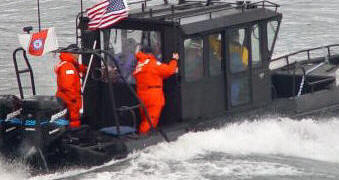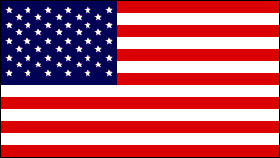|
|
Surface Operations - Equipment, Flags, & Signs
PROPER WEARING OF LIFE JACKETS
Members of the AUX under orders are to have life
jackets on and zipped up while on their boats. Life jackets are always
worn on piers and docks while performing line handling duties (tying up
boats, etc…). We set the example by displaying proper wear in photos or
on local/national television productions. Additional information
is available:
The Auxiliary Operations Policy Manual COMDTINST M16798.3E, page 4-25
Need for 2 Spare Life
Jackets
There has been discussion of the need for the 2 spare life
jackets, required to be onboard aux facilities, to also be rated for 50mph
if the facility can exceed 35mph.
We have determined, with input from both the Auxiliary STAN Team and the
Office of Boat Forces, that the 2 spare life jackets do not need to be
rated. The reasoning is the intended use of the spare jackets. They are not
intended to be used for crew and authorized guests who are required to have
properly rated life jackets. They are for PIW's or for passengers of a
vessel being towed. The logic being that the high speed ops are going to be
conducted 'getting on scene' and not 'on scene'. On the active duty side the
vests would be considered 'survivor vests' and not have to meet the same
standards as crew.
Public Safety Vessel Identification Light, "Safety
Light"
As per
The Auxiliary Operations Policy Manual
(COMDTINST M16798.3), pages 4-24 and 4-25, the
light may be used while under orders in the following situations:
•
When patrolling regattas and marine events.
•
When helping Coast Guard forces in maintaining security zones during
such events as shuttle launches and hazardous cargo transfers
•
When needed for brief periods of identification of the Auxiliary
facility. These periods include helping a boat in distress locate
the Auxiliary facility during a SAR case, warning boats away from
hazardous situation, or when SAR activity takes place within the
boundaries of regattas, marine events, or security zones.
An Auxiliary vessel
facility may not display the public safety vessel ID light under the
following circumstances:
• As
a towing light (see paragraph E.11 in the Operations manual)
•
During the prosecution of a SAR case, except as authorized above
Anti-exposure coveralls (Mustang
suits)
If the water temp is less than
60 degrees, anti-exposure coveralls are required. The Order Issuing
Authority may waive, on a single sortie basis, the wearing of hypothermia
protective devices in accordance with the
Rescue and Survival Systems
Manual, COMDTINST M10470.10 (series), if the degree of risk of hypothermia
is minimal (e.g., non-hazardous, daylight operations in calm water). the wearing of hypothermia
protective devices in accordance with the
Rescue and Survival Systems
Manual, COMDTINST M10470.10 (series), if the degree of risk of hypothermia
is minimal (e.g., non-hazardous, daylight operations in calm water).
The coxswain may request a
waiver from the OIA when there is concern about the adverse effects of
“thermal stress”. If an OIA waives the wearing of hypothermia protective
devices (for example Mustangs), Auxiliarists are still required to
carry Anti-exposure coveralls onboard the facility.
Emergency Position Indicating
Radio Beacons (PEPIRB) Requirements:
As of June 1st, 2004, Auxiliary surface
facilities (including PWCs) and special purpose facilities not equipped with a
406 MHz EPRIPB are required to have a minimum of one crew member
carrying a PERIRB while underway on orders. Coxswains who were never issued a PEPIRB,
get in touch with Stacy Curtin.
The life span of the PEPIRB batteries is about five years.
DIRAUX will be purchasing new batteries for the PEPIRBs as soon as funding
is available. Please advise
Mr.Kilburger,OTO, if your battery is due to be replaced in 2007 or 2008.
The expiration date is located on the back of the PEPIRB.
NATIONAL and AUXILIARY PATROL ENSIGNS


• All surface facilities underway must fly the National Ensign.
Some facilities find it necessary to take the flag down while doing
towing evolutions.
• While there is no law against flying the National Ensign at night, it is
customary to fly it only between sunrise and sunset when not underway.
• All facilities must fly the National Ensign whenever the Auxiliary Ensign
is flown.
• The National Ensign should be about one inch on the fly for each foot of
overall boat length. See below table for standard National Ensign sizes
relative to boat length.• Auxiliarists must never display the National Ensign upside down on
Auxiliary facilities. This is not a recognized international distress
signal because of the flags of many nations appear the same when flown
upside down.
• Make sure the National Ensign’s fly length is never less than the AUX
Patrol Flag’s fly length.
• Ensure your National Ensign has all fifty stars.
AUXILIARY FACILITY PATROL SIGNS


Starboard BOW
Port
• Auxiliarists operating AUX facilities on patrol must prominently display
the patrol signs. See below table for appropriate size of signs.
• These signs must be visible on both sides of the facility.
• A facility must not display patrol signs while it is not assigned to duty.
• If a facility is on ordered patrols for consecutive days, patrol signs may
remain displayed during periods of non-use.
• PWCs and special purpose facilities are exempt from the above provisions.
• Patrol sign lettering must be black or dark blue. A similarly colored sign
border or oversized mounting board is optional
• The top of the stripes always go forward on each side.
VESSEL LENGTH (FEET)
|
NATIONAL ENSIGN (INCHES)
|
AUX & PATROL ENSIGN
(INCHES)
|
AUX FACILITY PATROL SIGN
SIZES
|
14-18
|
12 X 24
|
9 X 15.5 (#5)
|
10 X 30 (#1)
|
18-24
|
16 X 24
|
12 X 21 (#4)
|
10 X 30 (#1)*
|
24-30
|
20 X 30
|
15 X 24 (#3)
|
12.5 X 60 (#2)*
|
30-36
|
24 X 36
|
24 X 36 (#2)
|
15.5 X 72 (#3)
|
over
36
|
30 X 48
|
30 X 48 (#1)
|
15.5 X 72 (#3)
|
*
#2 Sign can be used on vessels 20 to 30 feet
WHO CAN FLY THE AUX ENSIGN?

The Auxiliary Ensign may now fly only on
either inspected surface facilities that display a current facility decal or
on vessels owned by Auxiliarists that have successfully completed a Vessel
Safety Check and that display a current VSC decal.
Changes in regards to non-operational
facilities to the Auxiliary Operations Policy Manual COMDTINST
M16798.3(series) will be reflected in future editions of the manual.
To: ALAUX From: CHDIRAUX
Subj: Non-Operational Facilities Category
Eliminated -012/09

|

 the wearing of hypothermia
protective devices in accordance with the
the wearing of hypothermia
protective devices in accordance with the




